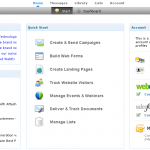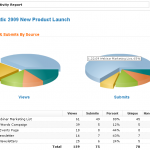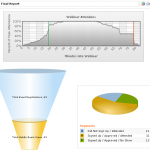Webinars are a proven way to generate and nurture leads. To make webinars logistics easier, I’d love to see a proper integration between Demand Generation systems and Webinar systems such as Webex Event Center or GoToWebinar (see my comment on Ken Molay’s webinar blog). Today they are separate so you are copying information back and forth, or you have to do an expensive custom integration.
 I’ve asked around, and today some people use the webinar system to send invitations and reminders and capture registrations, others do most of that within their demand generation system.
I’ve asked around, and today some people use the webinar system to send invitations and reminders and capture registrations, others do most of that within their demand generation system.
In the first case, you have an integrated process within the webinar system, including accurate reports on attendance. But your Demand Generation system is where you want to create a complete prospect profile, including email clicks and form submits. Also, you may want to export some campaign information (such as attendance) to Salesforce.com. This is often possible, but involves a lot of manual work.
In the second case, you capture the prospect information in the right place, but the Demand Generation system is not aware of the Webinar system. Therefore it takes more work than necessary to run your webinar campaign.
Act-On Demand Generation System
Today was the first time I saw an actual solution for this problem: Act-On is a relatively new player in the Demand Generation market. However, they come with good credentials: they’re funded by Cisco (owner of Webex), the CEO and engineering team come from Responsys (a leading marketing software vendor) and they have a seasoned executive team. Currently they have about 15 customers, from smaller companies to big names like BroadVision.
Their product is focused on small to medium size companies, so they’re not trying to compete with Eloqua or similar high-end products. Act-On Enterprise pricing starts at $500 per month (professional starts at $15 per month).
Act-On Enterprise includes most of the demand generation features that you’d expect, such as:
- Email marketing
- Drip email campaigns
- Form and Landing page builder
- Lead scoring
- Reporting
- Integration with Salesforce.com
But the unique feature is their integration with Webex. Read on…
Webex Webinar Integration
Act-On has a standard integration with Webex. Most of their customers use Webex Event Center. You can manage the entire webinar process from within Act-On. Only the actual delivery takes place in Webex:
- Promotion: Act-On
- Registration: Act-On
- Delivery: Webex
- Follow-up: Act-On
Normally these are silos that are disconnected, and now they are integrated, including end-to-end analytics. You can schedule the webinar from within Act-on (no need to login to Webex), and create a registration page, email invitation, repeat invitation, reminders and follow-up.
The Act-On home screen, lead source report, and attendance report
There are several cool features, such as the automatic inclusion of the webinar details in the email invitation. Also, you can generate dedicated registration page URLs to give to partners or to use in advertising, so you can see the source of the registrations.
Another useful feature is that it can update the Salesforce.com Campaign status: sent, received, registered, attended. This requires the ‘Marketing’ add-on in the Salesforce Professional Edition.
Conclusion
This is by no means a comprehensive review of Act-On, it is based on a short demo. However, I was impressed with the breadth of functionality, the ease of use, and the unique webinar integration. So take a look at it when you’re looking for a demand generation system and you do a lot of webinars. I’ve also added them to my list of Demand Generation software vendors.
My question to you:
Is webinar integration the next required feature for Demand Generation systems?

 In the old days, sales people managed the entire sales process: they took leads from the awareness phase, via discovery of possible solutions, to the final validation phase. Today, prospects get much of their information online, and often go through awareness and discovery without ever talking to a sales person. Sales may not be involved, but marketing for sure…
In the old days, sales people managed the entire sales process: they took leads from the awareness phase, via discovery of possible solutions, to the final validation phase. Today, prospects get much of their information online, and often go through awareness and discovery without ever talking to a sales person. Sales may not be involved, but marketing for sure…


 What I like about their offering is the simple packaging: you have the small company package for $250 per month, and the larger company offering for $500 (called ‘Marketer’). As a small company you have to use their content management system, and as a larger company you will use your own website (you just include some tags in the source of your site). Also, this ‘Marketer’ version includes integration with Salesforce.com for closed loop reporting: in other words, it will show which Google keywords result in how much revenue.
What I like about their offering is the simple packaging: you have the small company package for $250 per month, and the larger company offering for $500 (called ‘Marketer’). As a small company you have to use their content management system, and as a larger company you will use your own website (you just include some tags in the source of your site). Also, this ‘Marketer’ version includes integration with Salesforce.com for closed loop reporting: in other words, it will show which Google keywords result in how much revenue.